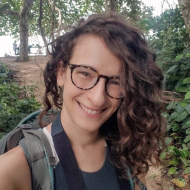Sessions
NCSE Director of Teacher Support Lin Andrews and NCSE Teacher Ambassadors Tom Freeman and Blake Touchet facilitated a well-attended session on the last day of the conference. Their presentation, Dismantling Misconceptions that Impede Scientific Understanding in the Classroom, provided attendees with an overview of the Supporting Teachers program and then delved into strategies teachers can immediately utilize in their classroom instruction to help students dispel their misconceptions. Freeman and Touchet led attendees through a draft of NCSE’s evolution lesson set 3: Time to Lose the Ladder. After providing an overview of the lesson set, Freeman and Touchet zeroed in on a specific activity titled Nature’s Doppelgangers. Attendees compared and contrasted two animals, then organized card sets describing the phenotypes of the animals into groups based on their phylogenetic relationships. They were then given a second set of cards representing the karyotypes of the organisms and asked to reorganize their groupings with the new information. Ultimately, teachers were able to create phylogenetic trees for the organisms and then compare them to ones created using the free phylogenetic tree creator phyloT. Teachers were excited to bring this free resource back to their classrooms in order to address misconceptions regarding convergent evolution.
In Are You Up to the Tusk?, NCSE Teacher Ambassador Rebecca Brewer helped session attendees analyze maps of African elephant population ranges and use gel electrophoresis to analyze DNA from a simulated ivory sample to better understand this keystone species’ ecological role. Brewer connected the science with historical and present-day justice issues related to the ivory trade and the effort to advance conservation efforts.
Understanding relationships between organisms is essential to understanding how life on earth evolved. The history of lizards tells the story of convergent evolution. In The Origin and Diversity of Armor in Girdled Lizards, NCSE Teacher Ambassador Jennifer Broo and Edward L. Stanley helped participants examine external morphological features of nine lizards to build a phylogenetic tree. As participants examined additional data from CT scans of the lizard’s osteoderm and graphical data showing the relationship between body shape, osteoderm coverage, and environment, participants reorganized the tree to show that convergent evolution creates analogous structures.
It took a lot of planning to ensure that NCSE would be able to conduct these events, but it’s definitely worth it: NABT is the leading organization of biology teachers in the nation, and there’s no better place than its annual conference for NCSE to share its latest work aimed at helping educators teach evolution effectively. If you’d like to support NCSE’s efforts, please donate today!





